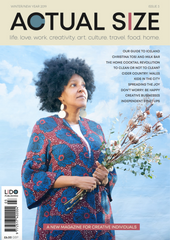Back in February, we were asked to write an article about Iceland for Actual Size Magazine, a recently launched print title aimed at creative, intelligent, culturally clued-up, design-conscious women. Here it is.
 The first time I went to Iceland, in 1999, before Game of Thrones and Walter Mitty established it in the public’s consciousness as a destination, the first person I had told of my plans, a work colleague, asked me ‘why?’
The first time I went to Iceland, in 1999, before Game of Thrones and Walter Mitty established it in the public’s consciousness as a destination, the first person I had told of my plans, a work colleague, asked me ‘why?’
Why indeed? All that was known about the island nations back then was that it was the home of Magnus Magnússon and Björk, was probably covered in ice, and the people had long names. Now of course most people are familiar with Ygritte’s cave, the unpronounceable volcano that grounded flights across Europe for weeks, and the impressive beard of Ólafur Darri Ólafsson from the TV series ‘Trapped’. But what was it that drew me to Iceland before it was famous? What keeps me coming back for more, 20 years and 15 visits later?
For starters, it’s one of the friendliest places I know. And I’ve lived in Lancashire. The locals will go out of their way to help visitors get the most of their time in Iceland, or to get to where they need, and they wear their hospitality as a badge of honour. I have stayed in hotels, bed and breakfasts and guest houses, but have always enjoyed the simple pleasures of staying with an Icelandic family. Farmhouses around the country have always welcomed visitors who book their accommodation through Hey Iceland, and with the advent of Airbnb it’s now easier than ever to find someone willing to give you a bed in the most remote parts of the countryside. So even if you’re a fan of the luxury life, I’d urge you to spend at least a couple of nights in a house with views of mountains (maybe even a waterfall) to one side, and the wild Atlantic Ocean to the other (as most places on the ring road can offer).
That’s not to say you can’t enjoy the city life too. Reykjavík is still, despite its recent exponential growth, a compact and characterful city where it’s easy to bump into the same person more than once. While there are no night clubs per se, the city’s social life revolves around its bars and coffee shops, many of which act as both, and are transformed at night into party spaces as local bands (of which there are hundreds) and DJs get to work. This is especially true during the annual Iceland Airwaves music festival, when aside from the many official gigs (which only paying wristband holders can attend), coffee shops, bookshops, record stores and even bus shelters host ‘off-venue’ performances which are free to attend.
On a hungover Sunday morning, after you’ve been up until 4am partying, you can grab one of the many restorative breakfasts on offer at Prikið, one of which even comes with a brace of painkilling tablets.
Iceland’s unusual traditional food (rotted shark, pickled ram’s testicles etc) is well documented, but has become a bit of a gimmick and seems a waste when there are so many great restaurants. A former fish factory in Reykjavík plays host to Matur og Drykkur (‘Food and Drink’), featured in the Michelin guide, where chef Arnar Sævarsson blends modern techniques with Icelandic ingredients to great effect. If your budget doesn’t stretch that far, then pop to the hot dog stall at the other end of the scale, Bæjrins Bestu Pylsur, (‘The Town’s Best Hotdogs’) where you can pick up eina með öllu (‘one with everything’) for a much less eye-watering amount. The queue that builds up late at night is testament to the little stand’s reputation.
There are no McDonalds or Burger Kings in Iceland, so you will need to go local if you fancy a burger. Hamborgarabullan’s burgers are so popular that they have branched our and now have two restaurants in London and one in Oxford.
The tapas restaurant Tapas Barinn (Vesturgata 3b) offers a variety of tasting menus with a local flavour, some of which include whale and puffin, or you can opt for more straightforward selections which include scallops, langousitines and other locally caught seafood.
If you have a sweet tooth, the Sandholt Bakery has been open since 1920 and apart from hand made fresh bread, offers amazing looking (and tasting) pastries, pies and fizzy drinks.
Back on the road to the countryside, there are plenty of tours operated by Iceland Excursions, but if you want to be a little more independent, rent a car and strike out on your own. I should stress at this point that parts of Iceland are still very dangerous, and not always in ways that you would expect, so always stick to roads that your vehicle is suited to, and if the local travel information says it’s not safe to travel, then stay where you are. During the summer the weather is much more hospitable and more roads are open, so if you want to visit places like Landmannalaugar, where naturally heated river water means you can bathe outdoors against a spectacular backdrop of multi-coloured mountains, or hike the Fimmvörðuháls trail past the aforementioned unpronounceable volcano (Ejyafjalljökull), then go between May and August. However if you want to see the aurora, late autumn to early spring, when the nights are longest, are the best times to travel, but the Icelandic weather will be at its most unpredictable (not that it’s particularly consistent at other times - the locals say that if you don’t like the weather, then just wait five minutes).
Iceland’s national ring road (Route 1) allows you to travel in either direction from Reykjavík and see most of the coast over a 1000 mile route that will take you through the vast majority of settlements in the country. As the interior of is uninhabitable, pretty much everyone lives on or near the coast, and with the exception of a few peninsulas (the most notable being Reykjanes, where the airport is based, Snæfellsnes and the Western Fjords) the ring road will take you past them all.
The Blue Lagoon, a naturally heated outdoor pool that lies between the airport and Reykjavik, has become almost too popular for its own good, and has introduced a booking system for casual swimmers who want to visit (you used to be able to just turn up and pay). If you'd prefer a less crowded experience, you can book into the Retreat Spa or the accompanying Retreat Hotel for private access to their secluded Retreat Lagoon, massages and other spa treatments.
Along the south coast are several spectacular waterfalls, most famously Seljalandsfoss and Skógafoss, but if you look out for the ‘place of interest’ symbol (⌘) on road signs you will almost certainly find some of the less touristy sites which are still worth a visit, especially if you have them all to yourself. Look out for Urriðafoss between the towns of Selfoss and Hella, and Fjaðrárgjúfur (feather canyon) near Kirkjubæjarklaustur, all within a day’s drive of Reykjavík.
In the opposite direction, north of Reykjavík is the Snæfellsnes peninsula. Visit the remote but luxurious Hotel Búðir with the nearby black church set against the backdrop of the spectacular Snæfellsjökull glacier, while further west the small town of Arnarstapi sits atop beautiful geometric basalt cliffs carved into unusual shapes by the sea, and further still, Djúpalónssandur beach is covered with polished black pebbles.
Iceland’s former State Architect, Guðjón Samúelsson, was responsible for many of Reykjavík’s public buildings built in the 20th Century, and he often took his inspiration from the shapes of Icelandic nature. The most famous (and prominent) of his works is Hallgrímskirkja (Hallgrimur’s Church), which sits at the top of the shopping street Skólavörðustígur, and offers views all over the city, from the harbour to the mountains. A lift takes you up the bell tower (for which you need to purchase an inexpensive ticket) so even those who don’t like stairs can take advantage. Make sure you check the time before ascending however as every quarter hour the bells will chime.
The main church interior is also beautiful, with sweeping arches and an impressive organ (no sniggering at the back). Guðjon’s other religious building in Reykjavík is the Catholic Cathedral which isn’t as dominant but still takes many of its visual cues from the columnar basalt found around Iceland, and is also worth a visit.
Head outside Reykjavík and you will find some more spectacular churches. You may spot one as you drive into the city from the airport after arriving - Kópavogur’s Church is nicknamed locally as the McDonald’s church (you’ll know why when you see it), and further north on the Snæfellsnes peninsula, both Ólafsvík and Stykkisholmur (on the aforementioned Snæfellsnes peninsula) have places of worship that look like they are from a science fiction film.
For non-religious architecture, a visit to Reykjavík’s brand new concert venue, Harpa, is essential. Also based on the columnar basalt structure, the glass hexagonal prisms that make up its facade are turned into a light show at night, and even occasionally turn into an interactive computer screen on which people can play Pong, or create their own custom light show.
If, after all that, you fancy some shopping, then head to Laugavegur, the city's main shopping street, or the Kólaportið flea market (weekends only), but I doubt you'll have time!
For more of photography of Iceland, see our photography store.




